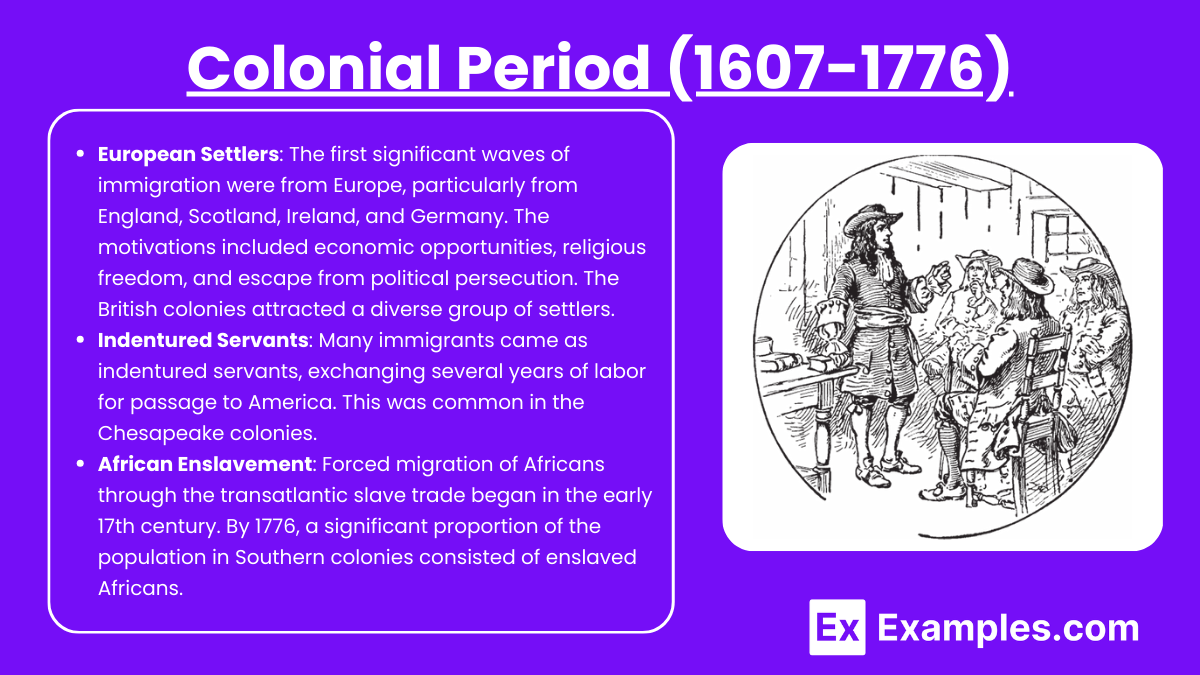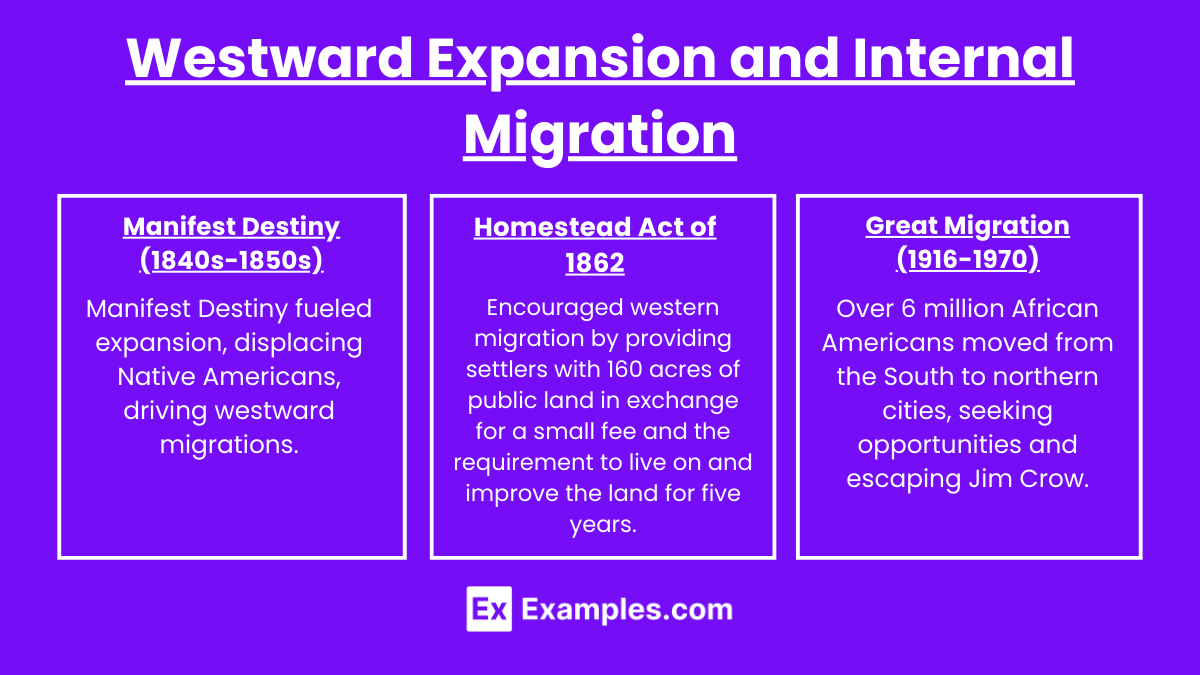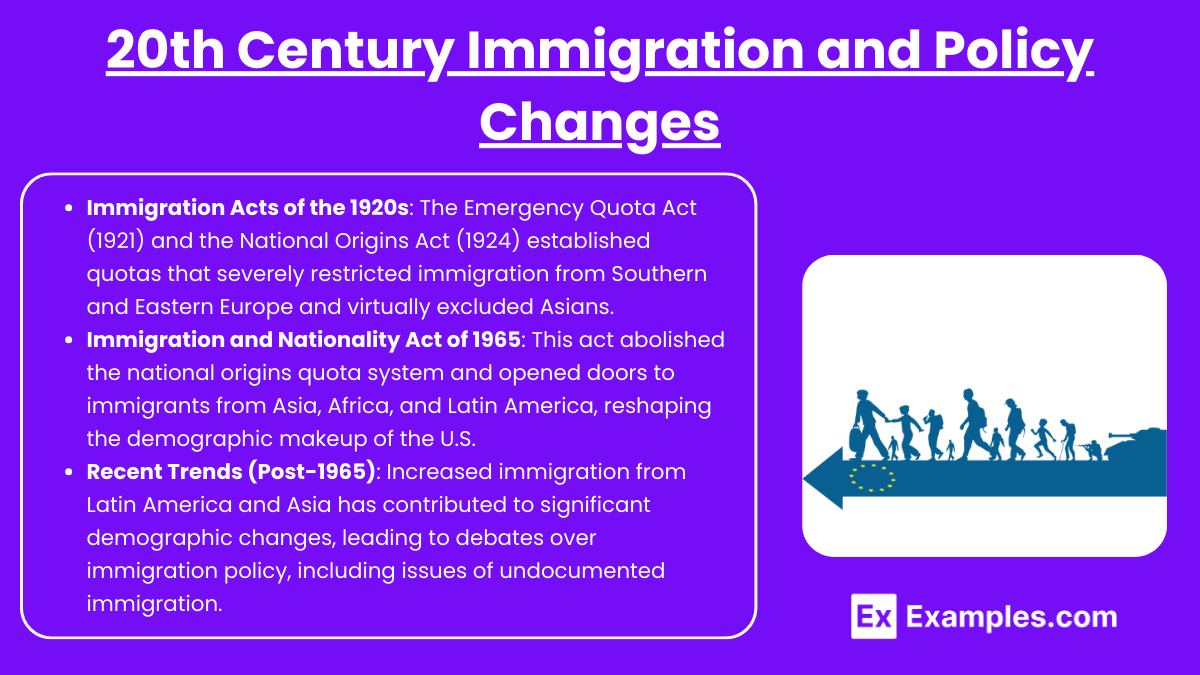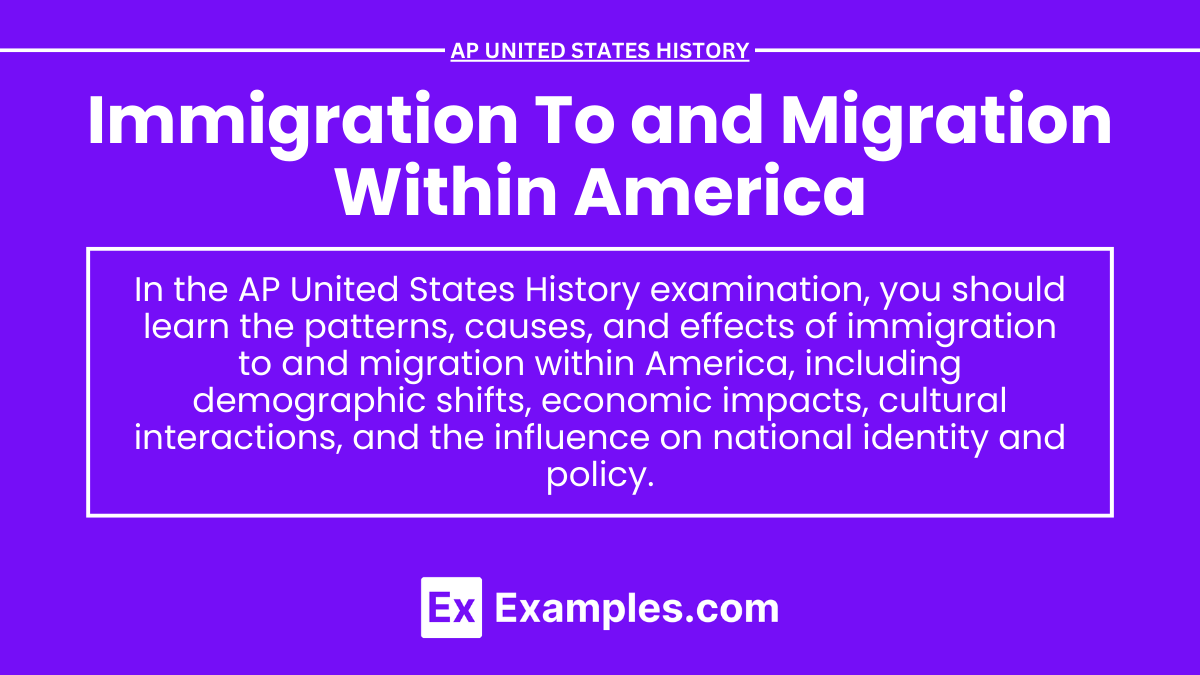In AP United States History, the topic of Immigration to and Migration within America encompasses the complex patterns of movement that have shaped the nation's demographic, economic, and cultural landscape. From the arrival of European settlers and the forced migration of Africans during the colonial period to the waves of European, Asian, and Latin American immigrants in the 19th and 20th centuries, these migrations reflect both the opportunities and challenges that have defined the American experience. Internal migrations, such as the westward expansion driven by Manifest Destiny and the Great Migration of African Americans, also highlight the dynamic nature of population movements within the United States. Understanding these patterns is crucial for analyzing the diverse and evolving identity of the nation.
Free AP United States History Practice Test
Learning Objectives
In the study of Immigration to and Migration within America, you will be expected to understand the diverse factors that motivated global immigration to the United States and internal migrations within its borders. You will be required to analyze the social, economic, and political impacts of these movements, identify significant legislative changes that influenced immigration patterns, and evaluate the effects of these migrations on American society, culture, and identity over time, reflecting the evolving nature of the nation.
Colonial Period (1607-1776)

European Settlers: The first significant waves of immigration were from Europe, particularly from England, Scotland, Ireland, and Germany. The motivations included economic opportunities, religious freedom, and escape from political persecution. The British colonies attracted a diverse group of settlers.
Indentured Servants: Many immigrants came as indentured servants, exchanging several years of labor for passage to America. This was common in the Chesapeake colonies.
African Enslavement: Forced migration of Africans through the transatlantic slave trade began in the early 17th century. By 1776, a significant proportion of the population in Southern colonies consisted of enslaved Africans.
19th Century Immigration (1800-1900)

The First Wave (1820s-1860s): Primarily involved Irish and German immigrants. The Irish fled the Great Famine (1845-1852), while many Germans fled political unrest. Many settled in urban areas and worked in factories, while Germans often moved to the Midwest to farm.
The Second Wave (1880s-1920s): This period saw a shift in immigration from Northern and Western Europe to Southern and Eastern Europe, including Italians, Jews, Poles, and Greeks. Many settled in urban ghettos, forming ethnic enclaves.
Chinese Exclusion Act (1882): Anti-Asian sentiment led to the Chinese Exclusion Act, which banned Chinese laborers from immigrating to the U.S., marking the first significant federal law restricting immigration.
Westward Expansion and Internal Migration

Manifest Destiny (1840s-1850s): The belief in Manifest Destiny drove American expansion westward, leading to the displacement of Native American populations. Internal migration included the Oregon Trail, the California Gold Rush, and settlement in the Midwest and Great Plains.
Homestead Act of 1862: Encouraged western migration by providing settlers with 160 acres of public land in exchange for a small fee and the requirement to live on and improve the land for five years.
Great Migration (1916-1970): The movement of over 6 million African Americans from the rural South to urban areas in the North, Midwest, and West, driven by economic opportunities and escaping Jim Crow laws.
20th Century Immigration and Policy Changes

Immigration Acts of the 1920s: The Emergency Quota Act (1921) and the National Origins Act (1924) established quotas that severely restricted immigration from Southern and Eastern Europe and virtually excluded Asians.
Immigration and Nationality Act of 1965: This act abolished the national origins quota system and opened doors to immigrants from Asia, Africa, and Latin America, reshaping the demographic makeup of the U.S.
Recent Trends (Post-1965): Increased immigration from Latin America and Asia has contributed to significant demographic changes, leading to debates over immigration policy, including issues of undocumented immigration.
Examples
The Great Famine (1845-1852): Led to a mass exodus of Irish to the United States, significantly impacting cities like New York and Boston.
Chinese Immigration and the Transcontinental Railroad (1860s): Chinese laborers played a critical role in building the Transcontinental Railroad, particularly in the western sections.
Ellis Island (Opened 1892): Served as the primary entry point for European immigrants, processing over 12 million immigrants until 1954.
The Dust Bowl Migration (1930s): Internal migration of families from the Great Plains to California, driven by environmental disaster and economic hardship.
Cuban Immigration after Castro's Revolution (Post-1959): A significant influx of Cuban refugees, particularly to Miami, Florida, after Fidel Castro's rise to power.
Multiple-Choice Questions (MCQs)
1. Which of the following was the primary cause of the Great Migration of African Americans from the rural South to the urban North during the early 20th century?
A. The Homestead Act
B. The abolition of slavery
C. Jim Crow laws and economic opportunities in the North
D. The Civil Rights Movement
Answer: C. Jim Crow laws and economic opportunities in the North
Explanation: The Great Migration was largely driven by the desire to escape the oppressive Jim Crow laws in the South and to find better economic opportunities in the industrial cities of the North.
2. The Chinese Exclusion Act of 1882 was significant because it:
A. Encouraged Chinese laborers to move to the western U.S.
B. Was the first significant federal law restricting immigration based on ethnicity
C. Allowed Chinese immigrants to gain citizenship more easily
D. Resulted in increased immigration from Europe
Answer: B. Was the first significant federal law restricting immigration based on ethnicity
Explanation: The Chinese Exclusion Act of 1882 marked a significant shift in U.S. immigration policy by explicitly targeting a specific ethnic group for exclusion.
3. The Immigration and Nationality Act of 1965 changed U.S. immigration policy by:
A. Reinforcing the national origins quota system
B. Opening U.S. borders exclusively to European immigrants
C. Abolishing the quota system and allowing more immigrants from Asia, Africa, and Latin America
D. Restricting immigration only to skilled workers
Answer: C. Abolishing the quota system and allowing more immigrants from Asia, Africa, and Latin America
Explanation: The 1965 Act abolished the restrictive national origins quota system, leading to increased immigration from non-European countries and a more diverse U.S. population.


